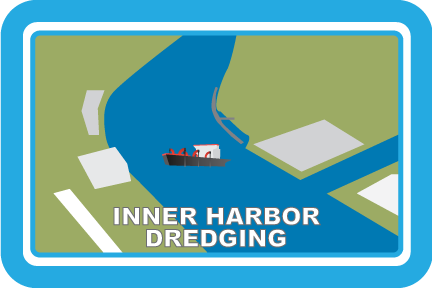
 Outer Harbor Dredging Outer Harbor Dredging
Award Status: Awarded $134.5 million contract to Great Lakes Dredge & Dock Company of Oak Brook, Illinois
Summary: The Dredge Alaska moved into the Atlantic Ocean Sept. 10, 2015 to begin deepening the harbor from its current 42-foot depth to 47 feet (slightly deeper in the ocean end of the harbor). The contract covers extending the entrance channel by 7 miles, and deepening of the outer harbor from approximately Fort Pulaski for 18.5 miles into the Atlantic Ocean. Dredging the outer harbor is the first step to deepening the entire 40-mile shipping channel and harbor from deep ocean to the Georgia Ports Authority terminal in Garden City. View the entrance channel progression map for the latest dredging forecast. |
| |
 Inner Harbor Dredging Inner Harbor Dredging
Award Status: Not advertised
Summary: The SHEP will deepen the Savannah harbor and the associated shipping channel from an authorized depth of 42 feet to 47 feet. This deepening will allow larger, more efficient container vessels to use the East Coast’s second busiest container harbor with fewer weight and tidal restrictions. Inner harbor work will also include constructing three bend wideners and two meeting areas, and enlarging the Kings Island Turning Basin at the Garden City Terminal. |

 CSS Georgia Recovery Effort CSS Georgia Recovery Effort
Award Status: Initial work awarded to Dial Cordy and Associates of Jacksonville, Florida. Panamerican Consultants of Memphis, Tennessee conducted field work. The U.S. Navy, which owns the vessel, recovered major pieces of the ironclad.
Summary: The remains of the CSS Georgia, a Confederate ship, previously rested on the bottom of the Savannah River adjacent to the shipping channel, near Old Fort Jackson. The CSS Georgia’s location impeded the channel expansion. Construction began in January 2015 when archaeologists mobilized for the first contract on the recovery of the CSS Georgia ironclad. The Corps of Engineers removed the remains from their location to protect them from further damage. Archeologists recovered more than 1,700 artifacts, most of which are related to the mechanics of the vessel. For more information on the current status of the CSS Georgia recovery process, visit its dedicated website. |
| |
 Dissolved Oxygen Injection System Dissolved Oxygen Injection System
Award Status: Awarded $99.6 million contract to CDM Constructors Inc. of Maitland, Florida
Summary: In July 2015, the Savannah District awarded a contract to begin building dissolved oxygen injection system systems upstream on Plant McIntosh and downstream of Hutchinson Island. Workers began clearing the land for construction in February 2016. The process will remove water from the river, inject it with oxygen inside 12, two story devices called Speece cones, and return the water back to the river. These devices will maintain the level of dissolved oxygen in the harbor at the pre-SHEP 47’ deepening level. The DO system is scheduled to be operational by December 2017. Keep up with its progress on our Flickr site. |
| |
 Raw Water Storage Impoundment Raw Water Storage Impoundment
Award Status: Awarded $40.2 million contract to Thalle Construction Company of Hillsborough, North Carolina.
Summary: Construction on the raw water storage impoundment began March 2016. We estimate active construction will take 18-21 months depending on weather and other factors. The impoundment, a small reservoir, will provide an additional resource of fresh water that may be needed when the Savannah River experiences drought conditions at extremely high tides in hot weather. Use of the impoundment during these rare occurrences ensures water quality remains unchanged. During normal operations, water will continue to be drawn from Abercorn Creek and will bypass the impoundment. During low river flows and high tides, pumping from Abercorn Creek will stop and water will be drawn from the impoundment until tides recede. |
| |
 Flow Re-routing Flow Re-routing
Award Status: Not advertised
Summary: The 47-foot plan includes several modifications to tidal creeks in the upper harbor. These changes will re-direct the flow of saltwater to significantly reduce the amount of impacts to freshwater marsh, which was determined the highest priority wetland natural resource in the Savannah River Basin. The flow re-routing plan will direct more freshwater into the Back River area on the South Carolina side of the river.
Flow re-routing would reduce salinity in 740 acres of salt marsh, converting it to brackish marsh (making it less salty, but not exceeding four parts per thousand of salinity). Studies show the wetlands will retain the same functional value, thus constituting “no net loss” of wetlands. |
| |
 New Savannah Bluff Lock and Dam Fish Passage New Savannah Bluff Lock and Dam Fish Passage
Award Status: Not advertised
Summary: The harbor deepening is expected to adversely impact habitat for one endangered species, the shortnose sturgeon. Harbor deepening would allow additional saltwater to enter the harbor and travel further upstream into areas currently used by this species. The increased salinity would reduce the suitability of some of these areas. To compensate for those impacts, the project includes construction of a fish passageway around the New Savannah Bluff Lock & Dam. This passage would restore access to historical spawning grounds for the shortnose sturgeon and other species. The design was coordinated closely with NOAA Fisheries with an estimated construction cost of $35 million. |
|

Caption
Workers flush munitions with hot water and MuniRem during inertion operations Nov. 4. Liquids carry black powder down a stepped trough system, which was built with 2-by-4s onsite. The stepped system is a means for collecting progressively finer black powder particulates, which are then scooped and further contained.
|